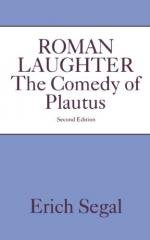|
This section contains 15,116 words (approx. 51 pages at 300 words per page) |

|
SOURCE: J. C. B. Lowe, "Aspects of Plautus' Originality in the Asinaria," in Classical Quarterly, Vol. 42, No. 1, 1992, pp. 152-75.
In the following essay, Lowe compares Plautus's Asinaria to its Greek model Onagos and identifies several aspects of Plautus's comedy which are perhaps Plautine innovations rather than further derivations from Greek materials.
Introduction
The problem of Plautus' originality
That the palliatae of Plautus and Terence, besides purporting to depict Greek life, were in general adaptations of Greek plays has always been known. Statements in the prologues of the Latin plays and by other ancient authors left no room for doubt about this, while allowing the possibility of some exceptions.1 The question of the relationship of the Latin plays to their Greek models was first seriously addressed in the nineteenth century, mainly by German scholars, under the stimulus of Romantic criticism which attached paramount importance to originality in art.2 Since...
|
This section contains 15,116 words (approx. 51 pages at 300 words per page) |

|


